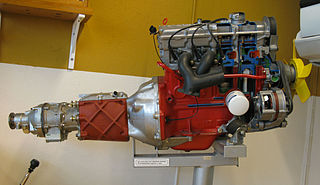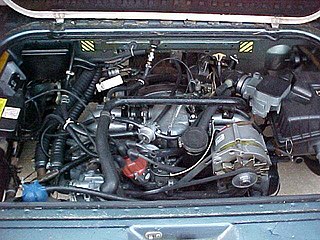
A camshaft is a shaft that contains a row of pointed cams in order to convert rotational motion to reciprocating motion. Camshafts are used in piston engines, mechanically controlled ignition systems and early electric motor speed controllers.

A four-strokeengine is an internal combustion (IC) engine in which the piston completes four separate strokes while turning the crankshaft. A stroke refers to the full travel of the piston along the cylinder, in either direction. The four separate strokes are termed:
- Intake: Also known as induction or suction. This stroke of the piston begins at top dead center (T.D.C.) and ends at bottom dead center (B.D.C.). In this stroke the intake valve must be in the open position while the piston pulls an air-fuel mixture into the cylinder by producing a partial vacuum in the cylinder through its downward motion.
- Compression: This stroke begins at B.D.C, or just at the end of the suction stroke, and ends at T.D.C. In this stroke the piston compresses the air-fuel mixture in preparation for ignition during the power stroke (below). Both the intake and exhaust valves are closed during this stage.
- Combustion: Also known as power or ignition. This is the start of the second revolution of the four stroke cycle. At this point the crankshaft has completed a full 360 degree revolution. While the piston is at T.D.C. the compressed air-fuel mixture is ignited by a spark plug or by heat generated by high compression, forcefully returning the piston to B.D.C. This stroke produces mechanical work from the engine to turn the crankshaft.
- Exhaust: Also known as outlet. During the exhaust stroke, the piston, once again, returns from B.D.C. to T.D.C. while the exhaust valve is open. This action expels the spent air-fuel mixture through the exhaust port.

A connecting rod, also called a 'con rod', is the part of a piston engine which connects the piston to the crankshaft. Together with the crank, the connecting rod converts the reciprocating motion of the piston into the rotation of the crankshaft. The connecting rod is required to transmit the compressive and tensile forces from the piston. In its most common form, in an internal combustion engine, it allows pivoting on the piston end and rotation on the shaft end.

In a piston engine, either a timing belt or timing chain or set of timing gears is a perishable component used to synchronize the rotation of the crankshaft and the camshaft. This synchronisation ensures that the engine's valves open and close at the correct times in relation to the position of the pistons.

An overhead camshaft (OHC) engine is a piston engine in which the camshaft is located in the cylinder head above the combustion chamber. This contrasts with earlier overhead valve engines (OHV), where the camshaft is located below the combustion chamber in the engine block.

The Pontiac straight-6 engine is a family of inline-six cylinder automobile engines produced by the Pontiac Division of General Motors Corporation in numerous versions beginning in 1926.
The Hyundai Beta engines are 1.6 L to 2.0 L I4 built in Ulsan, South Korea.

The Volvo B21 is a slanted straight-four engine first used in the Volvo 200 series, meant to replace the B20. The B21 and all derived engines are often referred to as red block engines for the red paint applied to the block. The primary differences when compared to the B20 was the switch to a SOHC in place of the older pushrod configuration, and an aluminum crossflow cylinder head versus the iron head of the B20.
In a piston engine, the valve timing is the precise timing of the opening and closing of the valves. In an internal combustion engine those are usually poppet valves and in a steam engine they are usually slide valves or piston valves.

Hydrolock is an abnormal condition of any device which is designed to compress a gas by mechanically restraining it; most commonly the reciprocating internal combustion engine, the case this article refers to unless otherwise noted. Hydrolock occurs when a volume of liquid greater than the volume of the cylinder at its minimum enters the cylinder. Since liquids are nearly incompressible the piston cannot complete its travel; either the engine must stop rotating or a mechanical failure must occur.
A rev limiter is a device fitted in modern vehicles that have internal combustion engines. They are intended to protect an engine by restricting its maximum rotational speed, measured in revolutions per minute (RPM). Rev limiters are pre-set by the engine manufacturer. There are also aftermarket units where a separate controller is installed using a custom RPM setting. A limiter prevents a vehicle's engine from being pushed beyond the manufacturer's limit, known as the redline. At some point beyond the redline, engine damage may occur.

The single overhead cam V6 engine introduced in 1993. It was derived from Chrysler's first homegrown front-wheel drive V6, the Chrysler 3.3 engine. The SOHC V6 has been replaced by the Chrysler Pentastar engine.

A valvetrain is a mechanical system that controls the operation of the intake and exhaust valves in an internal combustion engine. The intake valves control the flow of air/fuel mixture into the combustion chamber, while the exhaust valves control the flow of spent exhaust gases out of the combustion chamber once combustion is completed.

The Volkswagen wasserboxer is a four cylinder horizontally opposed pushrod overhead-valve (OHV) petrol engine developed by Volkswagen. The engine is water-cooled, and takes its name from the German: "Wasserboxer" ("water-boxer"); with "boxer" being another term for horizontally opposed engines. It was available in two displacements – either a 1.9-litre or a 2.1-litre; the 2.1-litre being a longer-stroke version of the 1.9-litre, both variants sharing the same cylinder bore. This engine was unique to the Volkswagen Type 2 (T3), having never been used in any other vehicle. Volkswagen contracted Oettinger to develop a six-cylinder version of this engine. Volkswagen decided not to use it, but Oettinger sold a Volkswagen Type 2 (T3) equipped with this engine.

The Mitsubishi 4B1 engine is a range of all-alloy straight-4 piston engines built at Mitsubishi's Japanese "World Engine" powertrain plant in Shiga on the basis of the Global Engine Manufacturing Alliance (GEMA). Although the basic designs of the various engines are the same, their exact specifications are individually tailored for each partner. The cylinder block and other basic structural parts of the engine were jointly developed by the GEMA companies, but the intake and exhaust manifolds, the cylinder head's intake and exhaust ports, and other elements related to engine tuning were independently developed by Mitsubishi.
The following outline is provided as an overview of and topical guide to automobiles:

The oil pump is an internal combustion engine part that circulates engine oil under pressure to the rotating bearings, the sliding pistons and the camshaft of the engine. This lubricates the bearings, allows the use of higher-capacity fluid bearings and also assists in cooling the engine.
The term power assembly refers to an Electro-Motive Diesel (EMD) engine sub-assembly designed to be "easily" removed and replaced in order to restore engine performance lost to wear or engine failure. Typical of heavy-duty internal combustion engines used in industrial applications, EMD engines are designed to allow the cylinder liners, pistons, piston rings and connecting rods to be replaced at overhaul without removing the entire engine assembly from its application location. This increases engine value, reduces downtime and allows the engine to be returned to true new engine performance. Other terms such as cylinder pack, liner pack, cylinder assembly and cylinder kit are used in the engine industry to describe similar assemblies. In the large-engine industry, the term "power assembly" has also become generic and is often used to refer to the assemblies used in non-EMD engines where "power pack" may be the preferred term, although both terms are functionally the same.
The Subaru six-cylinder engines are a series of flat-6 engines manufactured by Subaru, made in three distinct generations. The ER27, derived from the Subaru EA first-generation flat-4, was used as the sole engine option in the premium model 1988–91 Subaru Alcyone VX. The EG33, derived from the Subaru EJ second-generation flat-4, was used exclusively in the successor Subaru Alcyone SVX, again as its sole engine option, sold from 1991–96. The EZ series, consisting of the EZ30 and EZ36 models, was designed to be almost as compact as the EJ25 flat-4. The EZ30/36 were the first Subaru six-cylinder engines available outside the sport coupes, used as the uplevel option for Subaru Legacy (2002–19) and Outback/Lancaster (2001–19) as well as the sole option in the Subaru Tribeca (2006–14).

The Suzuki A100 is a Japanese motorcycle from the Suzuki Motor Corporation with production starting in 1966.Similar models were produced by Yamaha and Kawasaki with the YB100 & KH100 models, also with a single-cylinder two-stroke engine and rotary valve being examples.















